30+ Easy Acrylic Painting Tips For Beginners
Most newbie artists constantly research acrylic painting tips for beginners, and that’s understandable:
Acrylic paint is probably the most used medium thousands of artists incorporate in their works.
There is so much you can do with acrylic paint. Do you think you already know all there is to know about it?
Assuming you don’t, take a few minutes to read this blog post:
In today’s article, I’ll share my favorite acrylic painting tips for first-time artists.
Let’s begin, shall we?
Related Read:
Acrylic Painting Tips For Beginners
1) Find A Reference

So, you already have an idea about the painting you want to create. What’s the first thing you should do before you start painting?
The answer to that question is simple – put down the brush!
Before you do anything else, search for references online – the web offers plenty of images similar to the artwork you want to do.
Use that reference to guide and inspire you while working on the painting.
2) Experiment Before You Follow Any Instructions
While using a reference as a blueprint for your painting is important, it shouldn’t be the center of your creative process.
An image reference must boost your creativity, not replace it entirely.
For example, if you want to paint a cat, it’s OK if your artwork looks different than the photo reference you look at through the creating process.
Paint each element as you feel like it.
3) Use Professional Grade Paint
First and foremost, I would never recommend working with craft paint instead of professional grade on:
Sure, grade paint is a bit more expensive, but paying for it will be worth every cent:
Professional-grade paint contains more pigment, and you need that if you want to blend colors and achieve better coverage.
4) Buy The Basic Colors First

It’s tempting to buy as many colors as you can find as a first-time painter, but doing so is far from necessary.
Buying only the basic colors when you’re starting is one of the best acrylic painting tips for beginners I have for you today. Instead of wasting money on many acrylic colors, learn how to mix them and create colors on your own.
Basic colors are yellow, blue, red, and black – there are the only colors you need as a newbie artist.
5) You Can Use Acrylic Paint On Almost Any Surface
Most artists use acrylic paint on canvas. However, you can place acrylic paint on any other kind of surface you can think of.
Wood panels and acrylic paint will look good together, and so will watercolor paper, mixed media paper, and even glass.
Assuming you prefer to work with acrylic paint, don’t hesitate to add it to any surface you have in mind for your future artwork.
6) Create The Large Area First
Here is a quick question – what do you paint first? Do you create the large areas first, or do you start with adding smaller details?
Hopefully, you don’t begin the painting process by wasting time on the tiny details.
It’s always better to create the blogger areas of your painting first. Once they’re ready, you can take your time with placing specific details.
7) Do A Sketch First
Quite frankly, creating a sketch of your painting is not necessary if your niche as an artist is abstract artwork.
With that said, having a sketch that will serve as a draft of your painting is recommended if you prefer to create portraits or landscapes.
Use a pencil for your sketch, so you can easily remove it if the artwork doesn’t look as you intend it to.
Technique Acrylic Painting Tips
8) Start Painting With An Easel
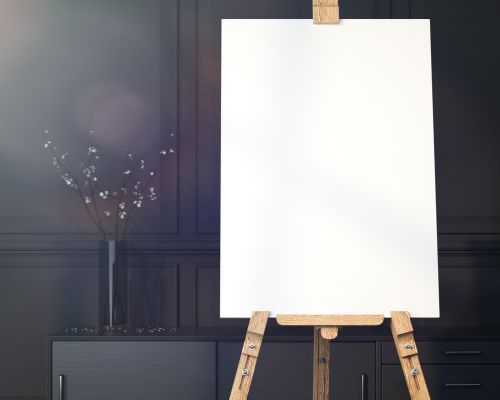
Considering this article is all about acrylic painting tips for beginners, there is no way I wouldn’t mention the easel:
As a beginner artist, using an easel is a must – it will allow you to steady your canvas without risking altering any proportions.
Of course, once you have enough experience as an artist, you can place your canvas on a table or work on the ground.
9) Try Different Acrylic Painting Techniques
When you’re just starting to paint, you don’t know yet all techniques you can do while working with acrylic paints.
That would change as you develop as an artist – the more you paint, the bigger would be the number of techniques you implement during the work process.
Eventually, you’ll probably find a technique you’ll make your own, and that technique might become the signature move behind your unique style.
10) Learn To Mix Colors
Are you sure you know how to mix colors? In case you’re not, pause your painting activities and take the time to master color mixing.
Every artist wants to extend their palette. And the best way to do that is to know how to mix colors well. As a rule of thumb, you can mix any color you can think of from the primary colors (yellow, red, and blue).
Experiment with mixing colors every time you paint. After all, practice makes perfect!
11) Create Texture
Do I have to be the one to tell you that acrylic paint is an excellent medium for creating texture?
The paint is thick enough. Therefore making areas of your painting ticker will look great once your artwork dries.
Of course, you should not add water when creating texture since it will slim the texture down.
12) Use Your Fingers
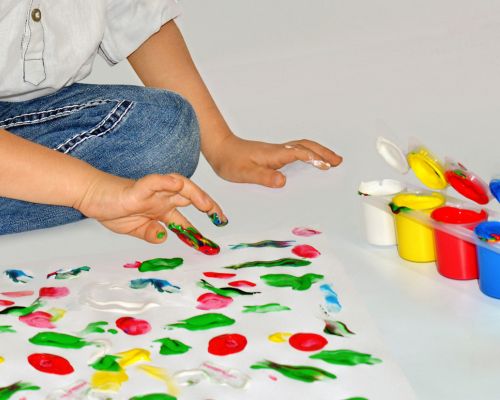
I know – using your fingers must be one of the weirdest acrylic painting tips for beginners you’ll ever hear.
Be that as it may, I have to mention it for one simple reason:
Not being afraid to use your fingers while working with acrylic paint will result in one-of-a-kind textures and strokes, so go for it!
13) Work Carefully With Pens
Are you using a pen on any of your acrylic paintings? And if you’re, are you doing it carefully?
I’m asking because an acrylic background and a pen are not the best combinations ever.
Markers will do a much better job than ordinary pens, so I suggest using them.
14) Use a Palette Knife For Mixing Colors And Strokes
In my opinion, no respectable artist would ever find themselves without a palette knife.
Palette knives are not expensive and are extremely valuable, especially when creating an acrylic painting.
Feel free to use a palette knife to add texture and mix your paint.
15) Paint Over Mistakes
What do you do when you make a mistake while working on a painting? Do you get a new canvas and start all over again?
You don’t have to do that, considering you can always paint over your mistake and still achieve the result you desire.
Painting over acrylic paint with more acrylic is easier than doing it with oil paint.
Tool Acrylic Painting Tips For Beginners
16) Clean Your Brushes
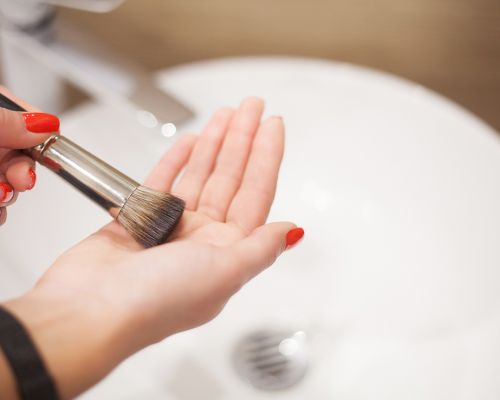
Quite frankly, I shouldn’t even have to tell you to clean your brushes – that goes without saying.
However, cleaning your brushes well each time you use them is essential because once acrylic paint dries on the brush, you’ll have difficulty removing it.
I clean my brushes with warm water and soap – you might want to give that a try too.
17) Store Your Brushes Properly
Here is a quick question:
What kind of care do your brushes receive? Do you even take a minute to make sure you’re not accidentally destroying them?
Properly storing your brushes is important – it will allow you to keep using them for the longest time possible.
18) Invest In Different Brush Shapes And Sizes
You can’t use a single brush as an artist – serious painters own different brushes in many shapes and sizes.
Working with acrylic paint requires the usage of at least a couple of different brushes to diversify your strokes:
Most artists use smaller brushes for details and bigger ones on larger areas of the painting.
19) Use A Few Brushes
I get it – the previous paragraph in this article about acrylic painting tips for beginners advises you to work with different brushes, while this one insists on using just a few.
That may sound confusing at first, but it’s not really:
Yes, owning brushes in different sizes is unavoidable, but that doesn’t mean you should buy every single brush you see in the art store.
Instead, purchase one brush in each size – that would be enough to begin your journey as a painter.
20) Use Synthetic Brushes
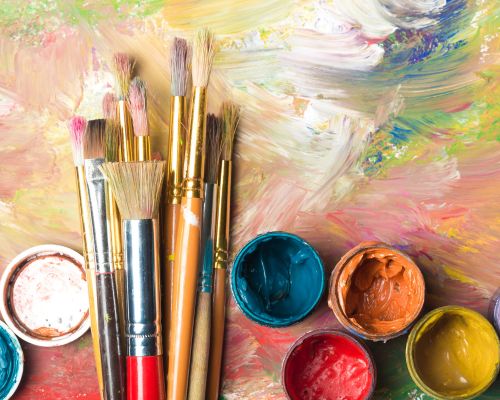
Think what you will, but synthetic brushes are the best – that’s just a fact!
Brushes made out of synthetic hair cost less than other brushes.
More importantly, synthetic brushes work better with the elements of acrylic paint.
More Acrylic Painting Tips For Beginners
21) Ask For Feedback
Once your painting is ready, don’t hesitate to show it to other people and fellow artists.
Getting quality feedback is an inseparable part of growing as an artist:
Just because your artwork looks great, that doesn’t mean it can’t be even better.
If you’re not a member of any Art-Focused Facebook Groups, now is the time to become one.
22) Accept That Some Acrylic Paint Darkens As It Dries
Don’t be surprised if certain elements of your finished painting look a bit darker than you anticipated them to be.
Certain acrylic paints tend to darken once they are dry:
The cheaper the paint is, the darker it will look when it becomes dry.
23) Use Two Jars Of Water Instead Of One
I guess you’ll agree with me that using two water jars instead of one is one of the most simple yet valuable acrylic painting tips for beginners:
One of the jars will serve you to remove the color you’re finished with for the moment. And the other one is necessary each time you want to thin the paint you’re currently using.
24) Keep Stepping Away From A Painting In Progress
Why does removing yourself periodically from artwork in progress matter?
Well, it matters because it will allow you to see the painting with fresh eyes and notice details you can’t see when you’re working on it constantly.
Also, you can turn your painting upside down and look at it that way – you’ll be surprised by the number of details that will reveal themselves!
25) Sign And Date Your Artwork
Generally speaking, most newbie artists feel uncomfortable signing up for their work – they feel that’s something only popular and established artists should do.
But that’s not true:
Signing up for a painting will provide you with the confidence and sense of ownership you most likely need as a beginner artist.
26) Take Pictures Of Your Artwork
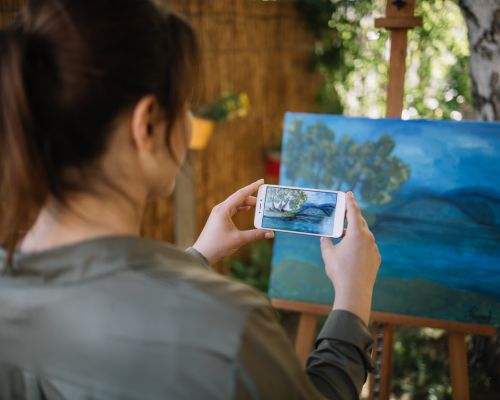
No two artists are the same – some are born with incredible talent, while others become better with practice.
There is one simple trick that will help you see your progress with your own two eyes – taking pictures of your artwork. Imagine the difference you’ll see when you look at an image of your first artwork and then a photo of a painting you did years later.
Let’s not forget that you can also use pictures of your artwork to increase your reach on social media and build an online portfolio.
27) Don’t Compare Yourself To Other Artists
Every artist is on their unique journey – that goes without saying.
Maybe other artists sell more paintings than you do. Or they have a bigger following on Social Media.
That’s all OK – keep tracking your progress and focus on improving your artistic and painting abilities.
28) Keep Practicing
I mentioned earlier in this article about acrylic painting tips for beginners that having a rough talent is not enough to become an incredible artist:
As you probably already know, the only way to improve your painting abilities is to constantly work on them.
Keep practicing even on days when you have no inspiration – discipline matters more than anything else.
Basic Acrylic Painting Tips For Beginners
- Paint in layers: Acrylic paint dries fast. Therefore, think of your acrylic artwork as a painting of layers – you can always paint over and add a new layer to your work in progress.
- Use wide strokes: Doing wide strokes will allow you to create more texture and cover larger areas of your painting.
- Add contrast by using warm and cold shades: Chances are, your painting won’t pop up in the eyes of potential buyers unless there is a contrast in it.
- Rely on the water to extend the drying time: I always have a plastic spray bottle of water nearby when I paint – get one as well and use it to increase the dry time of your artwork.
Final Say
Alright, these are all acrylic tips for beginners I have for you today.
I’ll probably add more at some point – I mostly work with acrylic paint when creating art (feel free to see my painting in my online store).
And what are your favorite acrylic painting tips?
Share them with me, and we can exchange ideas!